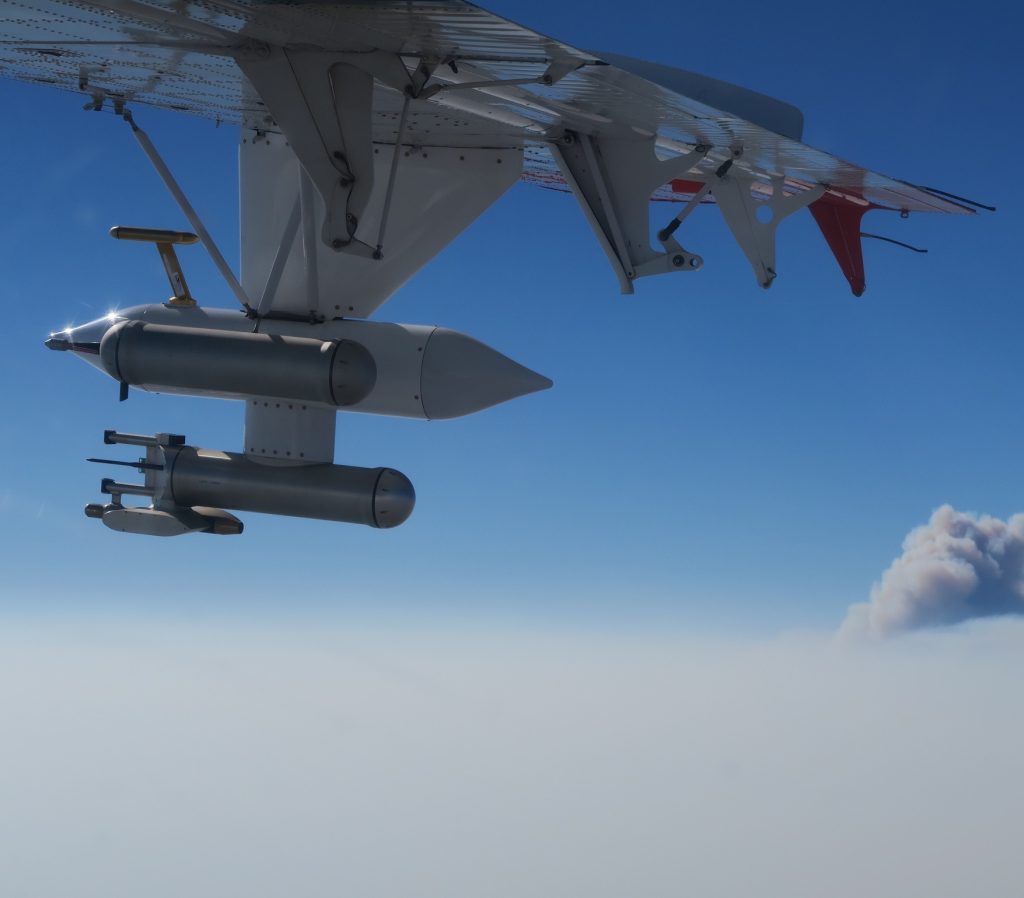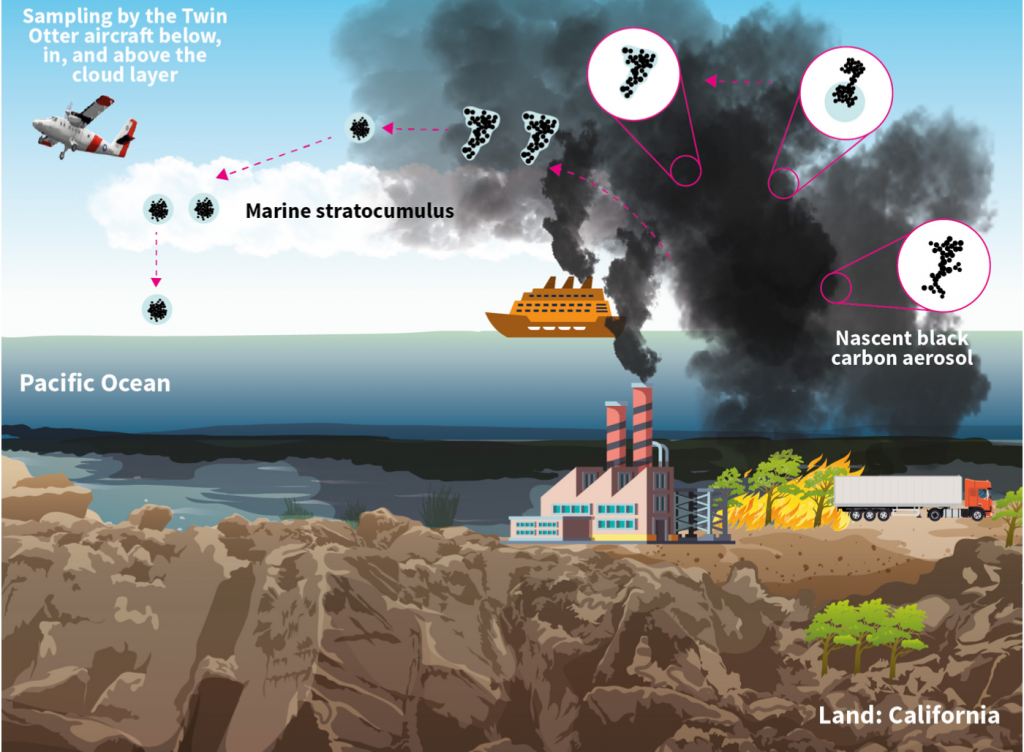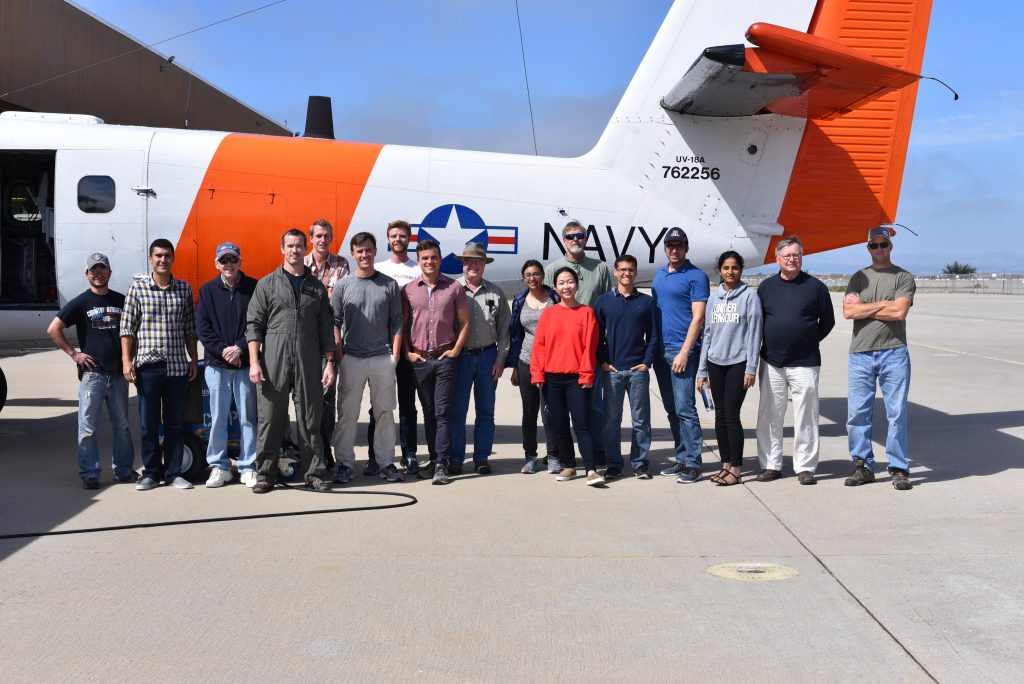Dr Andrew Metcalf – Exploring Atmospheric Soot to Protect People and the Planet
From wildfires to cargo ships, soot particles can originate from many different sources. Once emitted, these particles can be easily spread throughout Earth’s atmosphere. Dr Andrew Metcalf at Clemson University, and his graduate students Nilima Sarwar and Walt Williams, use advanced aircraft observations to investigate how the diverse characteristics of soot can be influenced by their sources, and assess their subsequent influence on air quality and cloud formation. Their work is now helping researchers to better predict the coming impacts of climate change, and to inform urgently-needed efforts to reduce our emissions.
An Understudied Emission
As Earth’s climate heats up, a deep and detailed understanding of how human activity is altering the atmosphere has never been more important. Although emissions of carbon dioxide and other greenhouse gases such as methane and nitrous oxide, have clearly been identified as a human-induced drivers of climate change, one particularly significant aspect of our emissions has so far received comparatively little attention.
Named aerosols, these tiny particles can originate from a diverse array of sources. One form of aerosol with an oversized influence on the atmosphere is ‘refractory black carbon’ – more commonly known as soot. Soot particles form when fuels don’t have sufficient access to oxygen to combust completely. The result is a mass of impure carbon, which is typically light enough to be carried upwards in the column of heat generated by the combustion and then to freely travel through Earth’s atmosphere.
Because they are so dark, soot particles are highly efficient at absorbing light, which causes them to heat up and warm the surrounding atmosphere. Alongside greenhouse gas emissions, the heat-trapping effects of soot particles exacerbate the climate-warming effects of fossil fuel combustion and wildfires. As wildfires are increasing in frequency and severity due to climate change, soot emissions from these fires could create dangerous climate feedback loops.
As well as influencing weather patterns and the global climate, soot also significantly influences air quality. As a result, a detailed understanding of their properties is crucial to researchers assessing levels of atmospheric pollution, threats to public health, and alterations to atmospheric processes – which can go on to affect the behaviour of Earth’s climate as a whole.

A Diversity of Characteristics
As Dr Andrew Metcalf of Clemson University points out, the physical properties of soot particles are far from uniform. For a start, they can originate from a wide range of possible sources, including wildfires, and the engines of ships, aircraft, and land-based vehicles – which all burn different types of fuel, and at different rates and temperatures. As a result, the aerosols can come in a diverse array of shapes, sizes, and chemical compositions, profoundly altering the ways in which they interact with light.
Yet the variations don’t stop there. After soot particles are emitted, they can interact with gas vapours and other types of aerosols – which may coalesce on the particle’s surface to form a coating. These coatings can make particles even more light-absorbing, alter the way in which they scatter light, and affect the way these particles interact with the environment.
Depending on the types and concentrations of naturally occurring aerosols they mix with in the atmosphere, their light absorption and scattering properties are altered to varying degrees. Dr Metcalf and his team aim to explore these properties in more detail – using measurements taken directly from the sky.
The MACAWS Project
In 2018, Dr Metcalf and his colleagues conducted the Marine Aerosol Cloud and Wildfire Study (MACAWS), which aimed to assess the impact of manmade aerosol particles from the marine shipping industry. To do this, the researchers used the Naval Postgraduate School (NPS) Twin Otter aircraft, which they equipped with several advanced instruments. These instruments included a Scanning Electrical Mobility Analyser, which can measure distributions of aerosol particle sizes, and an Aerosol Mass Spectrometer, which measures the chemical compositions of particles by breaking their constituent molecules into smaller fragments.
Although these devices had been used in previous aerosol measurement studies, MACAWS made one important addition to the arsenal of instruments aboard the NPS Twin Otter – the Single Particle Soot Photometer (SP2). This device allowed the team to measure how laser light interacts with a sample of particles. This interaction takes place in two possible ways: either by scattering the laser photons in many different directions; or through light emission after the particles have been heated by the laser. The light emission measurement is how soot is specifically identified in the SP2.

Observations from the Sky
For a month over the summer in 2018, the plane took several flights off the coast of Monterey, California, allowing Dr Metcalf’s team to characterise the nature of soot particles over the Eastern North Pacific region. While much of the California coastline is famously hot and sunny during the summer, conditions are very different on the central coast – the region close to San Francisco Bay which includes Monterey.
Each day, banks of large, low ‘marine stratocumulus’ clouds form in this region. As they hug the coastline, these formations keep the weather far cooler and cloudier than other coastal regions nearby. These conditions provide an ideal testbed to study interactions between soot particles and clouds, in an otherwise largely clean and unpolluted marine environment. Over the course of the MACAWS project, the researchers took measurements from several different flights of the NPS Twin Otter – both on clear and cloudy days.
In doing this, they hoped to answer several questions: including the effects of aerosol composition on the properties and formation mechanisms of clouds; the relationship between particle size, liquid water content of the cloud and ‘wet scavenging’ – through which water droplets form around aerosol particles and accelerate their removal from the atmosphere; and the effects of aerosol on accelerating the rates at which clouds lose their water content through precipitation. In addition, they hoped to discover how the sizes, distributions, and mixing of aerosols in the region compare with those found in other remote marine environments, and whether these characteristics can be used to determine aerosol sources.
Impacts on the Atmosphere
Through her graduate thesis project, Dr Metcalf’s graduate student Nilima Sarwar described how soot particles can have a profound influence on the processes that play out within the ‘marine boundary layer’. This part of Earth’s atmosphere lies just above the ocean, meaning the physical properties of both systems are closely linked. Through the MACAWS project’s observations, she discovered several clouds off the central California coast that had been polluted by the aerosols – with concentrations that became notably higher above the cloud layer.
Sarwar also found that due to wet scavenging, the liquid water content of these polluted clouds was around 22% lower than that in cleaner clouds. In addition, through empirical models of the interaction between clouds and soot particles, she predicted a maximum possible concentration for the aerosols within water droplets – providing a useful indicator for their influence on wet scavenging.
Alongside the measurements taken aboard the NPS Twin Otter, Sarwar used a combination of satellite images, and data on wind directions, to track the sources of soot particles. Through observations of wildfire smoke and exhaust plumes emitted by ships, she found that the above-cloud layer was strongly impacted by the long-range transport of soot from inland fires, while the lower parts of clouds could easily be polluted when the paths of ships passed directly beneath them.

Studying California Wildfires
Another graduate student of Dr Metcalf, Walt Williams, delved deeper into the characteristics of soot particles emitted by wildfires in California. Compared with aerosols from other sources, these particles have particularly distinctive size distributions and chemical compositions. In his graduate thesis, he aimed to gain a better understanding of background concentrations of soot particles during the summer wildfire season, as well as their size distributions, and their concentrations relative to other types of aerosols.
To do this, Williams used the NPS Twin Otter to measure the plumes emitted during the 2018 County Fire – which burned an area of 90,000 acres in the Sacramento Valley during July of that year. Through his analysis, he discovered that the air surrounding the fire carried as much as 100 times more soot by mass, and also displayed a larger characteristic aerosol size than would normally be present in the background airmass outside of the fire season.
Williams hopes that his results could help firefighters to better estimate the impact of future fires. In addition, they could allow health officials to estimate the chemical compositions of wildfire emissions – including those of other types of aerosols, simply based on measured concentrations of soot. This could provide critical information about air quality, and potential dangers to public health.
Improving Climate Predictions
The MACAWS project’s findings come at a critically important time in our efforts to prevent and mitigate climate change. For California, the threats posed by climate change are now a stark reality: in recent years, wildfires on unprecedented scales have increasingly come to capture news headlines around the world, and the trend is only expected to accelerate.
On a global scale, the threats posed by a warming climate have been made more abundantly clear than ever, by the Intergovernmental Panel on Climate Change’s most recent Assessment Report – with wildfires alone being expected to unleash ever greater damages on every inhabited continent in the coming decades.
As we come to realise the urgency of these warnings, a detailed knowledge of the role played by soot in influencing atmospheric processes, and how the properties of the particles can vary depending on their source, will allow researchers, including aerosol scientists, cloud physicists, meteorologists, and atmospheric modellers, to gain a far clearer picture of Earth’s climate as a whole and how it will change in the future. In turn, the team’s efforts could help us to better prioritise efforts to reduce our emissions, and to better prepare for the reality of a warmer world.
Reference
https://doi.org/10.33548/SCIENTIA749
Meet the researcher

Dr Andrew Metcalf
Department of Environmental Engineering and Earth Sciences
Clemson University
Anderson, SC
USA
Dr Andrew Metcalf earned his PhD in Environmental Science and Engineering at The California Institute of Technology in 2012. Upon graduating, he pursued postdoctoral roles at both Sandia National Laboratories and the University of Minnesota. Dr Metcalf has been an Assistant Professor of Environmental Engineering and Earth Sciences at Clemson University since 2017. His main research interests lie in air pollution and air quality, with a particular focus on atmospheric aerosol particles. As leader of the Clemson Air Quality Lab, he explores the properties of air pollution on many different scales: from measurements taken under a microscope to samples taken from large-scale field projects. Alongside his research, he also dedicates his time to training the next generation of scientists and engineers, by teaching several courses on air pollution engineering, combustion, and aerosols and climate, and supervising students conducting research projects.
CONTACT
E: ametcal@clemson.edu
W: https://cecas.clemson.edu/airqualitylab/
KEY COLLABORATORS
Nilima Sarwar, Clemson University
Nilima Sarwar completed her Master’s degree at Clemson in 2021. She is now pursuing opportunities to study for a PhD.
Walt Williams, Clemson University
Walt Williams graduated with a Master’s degree from Clemson in 2019. He now works as an air quality consultant at TRC, Inc., where he focuses on ambient air monitoring and greenhouse gas emission reduction projects.
The MACAWS research team also consisted of researchers from the California Institute of Technology and the University of Arizona.
FUNDING
US National Science Foundation: grant numbers #1833008 and #2113160


Want to republish our articles?
We encourage all formats of sharing and republishing of our articles. Whether you want to host on your website, publication or blog, we welcome this. Find out more
Creative Commons Licence
(CC BY 4.0)
This work is licensed under a Creative Commons Attribution 4.0 International License. 
What does this mean?
Share: You can copy and redistribute the material in any medium or format
Adapt: You can change, and build upon the material for any purpose, even commercially.
Credit: You must give appropriate credit, provide a link to the license, and indicate if changes were made.
More articles you may like
Grandmothers: Innovation Through Tradition
Grandmother Project – Change through Culture (GMP) is an organisation dedicated to documenting the role of grandmothers and demonstrating the effectiveness of grandmother-inclusive strategies in improving the health and well-being of women, children, and adolescents. GMP’s groundbreaking work challenges conventional wisdom to transform community-based interventions in Africa and beyond, harnessing a powerful but often overlooked resource: the wisdom and influence of grandmothers.
Dr Robert Larkin | Cultivating Change to Improve Soil Health and Increase Potato Yield
Environmental quality and food production are facing the pressing challenges of climate change and global population growth. Dr Robert Larkin from the United States Department of Agriculture-Agricultural Research Service (USDA-ARS) and a team of plant scientists developed and tested a range of crop management systems to help overcome these compounding challenges. Their work is improving soil health and increasing the yield of potato crops, contributing to the future food security of nations.
Professor Giorgio Buttazzo | Artificial Intelligence and a Crossroads for Humanity
Where do we stand with artificial intelligence? Might machines take over our jobs? Can machines become conscious? Might we be harmed by robots? What is the future of humanity? Professor Giorgio Buttazzo of Scuola Superiore Sant’Anna is an expert in artificial intelligence and neural networks. In a recent publication, he provides considered insights into some of the most pressing questions surrounding artificial intelligence and humanity.
Dr Ralf Adam | New Technologies Shaping the Future of Oral Hygiene
Understanding the efficiency of various toothbrush technologies is essential for achieving optimal oral health. Dr Ralf Adam, who leads a dedicated team at Procter & Gamble in Germany, is keen to investigate the complexities of these technologies. His team have provided new insights into the best toothbrush types for plaque removal and the maintenance of gum health. By highlighting the importance of informed oral care decisions and ongoing investigations, this vital research works towards ensuring everyone can achieve a brighter, healthier smile.




